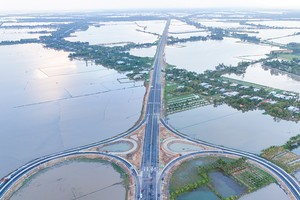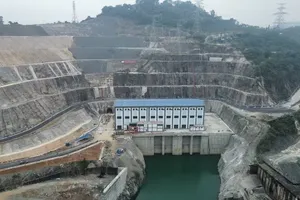The analysis result of 12 samples of seawater and sediment collected by the Central and Central Highlands Environmental Protection Department and the Department of Natural Resources and Environment of Quang Ngai Province in early December at Khe 2 Sea in Binh Thanh Commune in Binh Son District showed that five out of ten inshore seawater samples had total suspended solids exceeded standards by 1.2 times to 9 times.
The number of Silica algae in phytoplankton was up to 420,700 cells per liter of seawater, of which Asterionellopsis glacialis had the highest density of up to 304,213 cells per liter. Ten out of ten inshore seawater samples had synthetic parameter of lignin and tannin compounds with average content of 0.88 milliliter per liter, the lowest level was 0.22 milliliter per liter and the highest 1.74 milliliter per liter. The VEA concluded that change in color of seawater was because of high density of Silica algae and lignin and tannin compounds.
High density of Silica algae will change the color of seawater to brown or dark green and normally will not harm marine life. At the same time, the appearance of lignin and tannin compounds in this waters caused color of seawater to change to brown or black. These compounds are usually produced from processing activities relating to wood, wood chips and pulp from wood chips.
Meanwhile, at the waters of Hao Hung port of Hao Hung Limited Company, the color of seawater also changed to black. At this area, after the Matmo and Nakri storms, rainwater impregnated from wood chip field flowed to the sea. The VEA will continue to monitor the developments.
The number of Silica algae in phytoplankton was up to 420,700 cells per liter of seawater, of which Asterionellopsis glacialis had the highest density of up to 304,213 cells per liter. Ten out of ten inshore seawater samples had synthetic parameter of lignin and tannin compounds with average content of 0.88 milliliter per liter, the lowest level was 0.22 milliliter per liter and the highest 1.74 milliliter per liter. The VEA concluded that change in color of seawater was because of high density of Silica algae and lignin and tannin compounds.
High density of Silica algae will change the color of seawater to brown or dark green and normally will not harm marine life. At the same time, the appearance of lignin and tannin compounds in this waters caused color of seawater to change to brown or black. These compounds are usually produced from processing activities relating to wood, wood chips and pulp from wood chips.
Meanwhile, at the waters of Hao Hung port of Hao Hung Limited Company, the color of seawater also changed to black. At this area, after the Matmo and Nakri storms, rainwater impregnated from wood chip field flowed to the sea. The VEA will continue to monitor the developments.
























